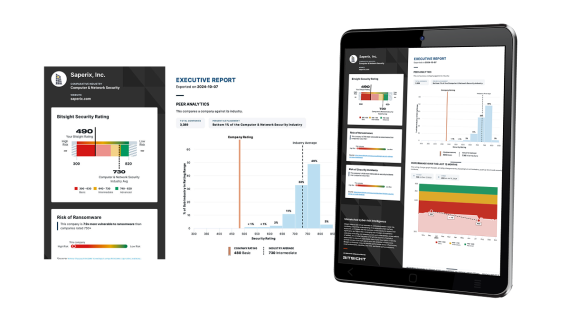Request a free executive report, which includes your security rating, for your company to find the gaps in your security program and how you compare to others in your industry.
Reduce the Risk of DNS Spoofing: Quickly Find and Fix DNSSEC Misconfigurations

There are many ways that a bad actor can infiltrate your IT infrastructure and begin sifting through your data. These vulnerable entry points are known as risk vectors and include insecure endpoints, unsupported mobile devices, unpatched systems, and more.
One risk vector gaining popularity with hackers are Domain Name System (DNS) attacks. The Domain Name System Security Extensions (DNSSEC) protocol is designed to mitigate these attacks.
The DNSSEC protocol is a public key encryption that authenticates DNS servers and protects your organization’s web domains from DNS spoofing attacks. These hacks occur when a threat actor exploits a misconfigured DNS server to redirect domain traffic to a malicious website – prompting visitors to enter sensitive information in the wrong place. Common methods of DNS spoofing include man-in-the-middle attacks and DNS server hijacking. It’s a significant risk that can lead to data theft, malware infection, and more.
Worryingly, these attacks are on the rise. Last year, 72% of organizations reported experiencing a DNS attack. While the DNSSEC can help bring this percentage down, the protocol needs to be configured correctly. DNSSEC misconfigurations pose an open door for hackers seeking to exploit DNS vulnerabilities.
How to find DNSSEC misconfigurations: see your network the way hackers do
Unfortunately, as your digital infrastructure expands to include a growing number of websites and servers, identifying DNSSEC misconfigurations isn’t easy and can involve a time-consuming audit. It’s no surprise that only 31% of organizations are confident in their preparedness to deal with a DNS attack.
One way to streamline this task – without incurring additional resources – is to conduct an external scan of your network endpoints. When you see your network the way hackers do, it becomes easier to identify and close security gaps, such as those presented by misconfigured DNSSEC protocols.
For instance, using Bitsight Attack Surface Analytics you can automatically and continuously test for gaps in your DNS protections and see if your DNSSEC configuration is functioning correctly.
Part of the Bitsight for Security Performance Management suite of solutions, Bitsight Attack Surface Analytics works by taking inventory of your digital assets, including DNS servers – on-premises, in the cloud, and across geographies and business units. Once discovered, you’ll get dashboard views of each asset and any risk that may be present, such as a DNSSEC misconfiguration.

How to fix DNSSEC misconfigurations
An attack surface scan is a consistent and uniform approach to identifying DNS vulnerabilities. It eliminates the need for a time-consuming and costly security audit of your web servers. Instead, with the real-time insights that Bitsight provides, you can move quickly to remediate the risk of a DNS spoofing attack.
To do this, follow these four steps:
- Set up DNSSEC for your domain. This includes generating the appropriate keys and updating DNS zone records.
- Generate a Zone Signing Key using the RSA or DSA algorithm with a key of 2048 bits or more.
- Download updated trust anchors and set them to be managed automatically.
- Add your DNSKEY to your DNS records through your registrar’s management interface.
Quickly discover other network vulnerabilities
Bitsight Attack Surface Analytics isn’t limited to pinpointing DNS misconfigurations; it also keeps a pulse on all emerging vulnerabilities, including insecure access ports, the presence of malware, unsupported server software, unpatched systems, and other risk vectors – so you’ll always know where cyber risk lies hidden in your digital environment.
Gain visibility into your attack surface. Request your free attack surface report today.


